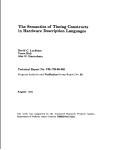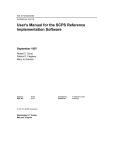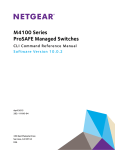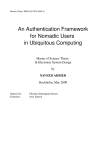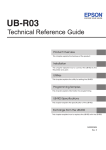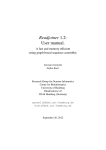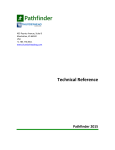Download User`s Manual for the SCPS Transport Protocol MITRE
Transcript
WN 97W0000018
WORKING NOTE
User's Manual for the SCPS Transport
Protocol
March 1997
Robert C. Durst
Patrick D. Feighery
Eric J. Travis
Sponsor:
Dept. No.:
MITRE
SMC/AXE
W159
3
Washington C Center
McLean, Virginia
Contract No.:
Project No.:
F-19628-94-C-0001
03970638
Abstract
This document provides the information necessary to write programs that use the Space
Communications Protocol Standards (SCPS) Transport Protocol (SCPS-TP). The primary
content of this document is Unix-style manual pages that describe how the Berkeley Socket
Interface has been extended to support SCPS-TP.
This document does NOT provide information necessary to build a distribution of the
SCPS-TP software. Such information is provided as documentation with reference
implementation of the SCPS protocols or with whatever distribution of the software the user
might have.
This document assumes that the reader is familiar with the Berkeley Socket Interface and
with the basics of the Transmission Control Protocol (TCP) and the User Datagram Protocol
(UDP).
KEYWORDS: SCPS, SCPS-TP, TCP, UDP, Socket
iii
Table of Contents
Section
Page
1
Introduction
2
Overview of SCPS Transport Protocol Capabilities
2.1
Differences Between Communications Environments
2.1.1 Bit-Error Rates
2.1.2 Round Trip Delay
2.1.3 Continuity of Connectivity
2.1.4 Forward and Reverse Link Capacity
2.1.5 CPU and Memory Capacity
2.1.6 Communication Goals
2.1.7 Primary Source of Data Loss
2.2
Modifications to TCP to Address Communication Problems
2.2.1 Bit-Error Rates
2.2.2 Round Trip Delay
2.2.3 Continuity of Connectivity
2.2.4 Forward and Reverse Link Capacity
2.2.5 CPU and Memory Capacity
2.2.6 Communication Goals
2.2.7 Primary Sources of Data Loss
2.3
Configuring SCPS-TP to Enable Specific Capabilities
2.3.1 Congestion Control
2.3.2 Selective Negative Acknowledgment
2.3.3 SCPS-TP Header Compression
2.3.4 Rate Control
2.3.5 Acknowledgment Frequency Reduction
2.3.6 Record Boundaries
2.3.7 Partial Reliability
3
5
6
6
7
7
7
7
8
8
9
10
10
11
12
13
14
15
15
16
16
16
17
17
17
3
Manual Pages for SCPS-TP
19
4
Suggested Reading
37
Appendix
1
Example Code
39
Glossary
47
v
List of Tables
Table
Page
1
Factors Affecting TCP Performance in Non-Terrestrial Environments
5
2
SCPS-TP Modifications to TCP to Address Communication Problems
9
vi
Section 1
Introduction
In the fall of 1992, NASA and the DOD jointly established a technical team (the SCPS
Technical Working Group, or “SCPS-TWG”) to explore possibilities for developing common
space data communications standards, with a principal focus on the activities associated with
in-flight monitoring and control of civil and military spacecraft. In practical terms, these
activities involve a ground control center conducting a dialog with a remote spacecraft to
transmit telecommands, to up-load and verify onboard software loads, and to confirm correct
spacecraft performance via a flow of telemetry.
The team adopted a two-pronged approach in its study phase: part of the team conducted
a top-down survey of representative civil and military space data communications
requirements, while the remainder of the team conducted a bottom-up analysis of available
standard data communications protocols. The team compared the results to see how
capabilities matched requirements, and formulated recommendations for future work. In
evaluating existing capabilities, first priority was given to commercially-supported “off the
shelf” standards. However, recognizing unique requirements of the space mission
environment (long propagation delays, noise-induced errors, and limited spacecraft data
processing resources and communications capacity), the team also considered other options.
By the end of 1993 the team concluded that wide segments of the U.S. civil and military space
communities have common needs for:
•
An efficient file handling protocol, capable of supporting file transfers initiated either
from ground-based systems or space-based systems
• A data transport protocol that provides the user with selectable levels of reliability,
based on operational need, between computers that are communicating over a network
containing one or more space data transmission paths
• Optional data protection mechanisms to assure the end-to-end security and integrity of
such message exchange
• An efficient protocol to support connectionless routing of messages through networks
containing space data links.
Following the study phase, the SCPS-TWG began development of four specifications, one
for each of the protocols, that address the above requirements: the SCPS File Protocol
(SCPS-FP), the SCPS Transport Protocol (SCPS-TP), the SCPS Security Protocol (SCPSSP), and the SCPS Network Protocol (SCPS-NP). These draft specifications have been
submitted for adoption as military standards as international standards. At the completion of
these standards activities, resulting standards may then be adopted by any military, civil, or
commercial organization for use in any space system. It is the intent of NASA and DOD that
1
commercial vendors produce the SCPS protocols as widely-distributed commercial products,
thus helping to reduce the cost of space systems while increasing their interoperability.
Part of the protocol development includes development of a reference implementation of
each of the protocols. This reference implementation is being made available for the purposes
of evaluation and experimentation with the protocols by potential users of the SCPS
capabilities. The SCPS-TP has been implemented so as to present a familiar programming
interface to users: the Berkeley Socket interface. This document describes the SCPS
extensions to the Berkeley Socket interface that allow users to take advantage of the SCPSTP capabilities.
This user’s guide continues in Section 2 with an overview of the major SCPS-TP
capabilities. The material in Section 2 explains and motivates the options available in the
SCPS-TP programming interface. Section 3 documents this interface by means of a series of
Unix manual pages for SCPS-TP. Finally, Section 4 presents suggested reading for those
readers not familiar with TCP, UDP, or the Berkeley Socket Interface.
2
Section 2
Overview of SCPS Transport Protocol Capabilities
The SCPS Transport Protocol is designed to support current and upcoming tactical and
space communication environments. The modifications to the base protocols are intended to
address the communication environments and resource constraints that systems fielded into
these environments typically face.
As a result of the study phase, several technical requirements were allocated to the
transport layer of the Open Systems Interconnect model. These requirements include the
following:
–
support for communication with full reliability, partial reliability, and minimal
reliability;
–
efficient operation in a wide range of delay, bandwidth, and error conditions;
–
efficient operation in space-based processing environments;
–
support for precedence (priority);
–
support for connectionless multicasting;
–
support for packet-oriented applications.
The SCPS Transport Protocol (SCPS-TP) refers collectively to the protocols that provide
the full reliability, best-effort reliability, and minimal reliability services. The full reliability
service is provided by the Transmission Control Protocol (TCP). The partial reliability service
is provided by TCP with minor modifications. The minimal reliability service is provided by
the User Datagram Protocol (UDP).
The SCPS-TP addresses the constraints posed by the operating environment with the
following extensions and modifications to TCP:
–
Window scaling (specified in RFC 1323)— addresses communication environments
that may have more than 65k bytes of data in transit at one time,
3
–
Round Trip Time Measurement (specified in RFC 1323) — This enhancement
addresses environments that have high loss, changing delays, or large amounts of data
in transit at one time.
–
Protect Against Wrapped Sequence Numbers (specified in RFC 1323)— This
capability, which uses the Round Trip Time Measurement capability, addresses very
long delay or very high bandwidth environments.
–
Selective Negative Acknowledgment (SNACK - specified in the SCPS Transport
Protocol, adapted from RFC 1106) — SNACK improves performance in high loss
environments by providing specific information about missing data and requesting its
immediate retransmission.
–
Record Boundary Indication (specified in the SCPS Transport Protocol) — This
feature provides the ability to mark and reliably carry end-of-record indications for
packet-oriented applications.
–
Partial Reliability Communication (specified in the SCPS Transport Protocol) — This
capability provides the ability for an application to select correct, in-sequence, but
possibly incomplete delivery of data.
–
Header compression (specified in the SCPS Transport Protocol, adapted from RFC
1144)— This technique reduces the overhead of TCP headers, typically by more than
50%, for application in low-bandwidth environments.
–
Low-loss congestion control or optional non-use of congestion control (specified in
the SCPS Transport Protocol) — Congestion control mechanisms prevent TCP from
overdriving shared links. If links are not shared, users can disable congestion control
and depend solely on SCPS-TP’s rate control mechanism to prevent overdriving the
communication channel. Alternatively, SCPS-TP provides a congestion control
mechanism that does not depend on data loss to signal congestion.
–
Retransmission strategies for mixed-loss environments that accommodate loss due to
data corruption, link outages, and congestion (specified in the SCPS Transport
Protocol).
–
Acknowledgment strategies for highly asymmetric communication channel capacities
(specified in the SCPS Transport Protocol).
This section discusses the problems that might be encountered in the tactical and
spacecraft communications environments, then identifies the solutions that SCPS-TP uses to
4
address those problems. Finally, this section discusses how to configure SCPS-TP to enable
the specific capabilities that provide the required solutions.
2.1 Differences Between Communications Environments
The Transmission Control Protocol (TCP) provides an excellent base of technology for
extension. It is a highly robust protocol, widely distributed, and is freely available. Hundreds
of individuals, world-wide, work to ensure that TCP continues to meet the needs of the
Internet community. The Internet community currently employs a terrestrial communication
environment, and TCP is optimized to provide service to this environment. The space and
tactical communication environments may have many similar communication characteristics to
the terrestrial environment by virtue of operating across terrestrial networks as part of the
end-to-end network. However, there are significant differences between the terrestrial and
space/tactical environments that affect communication protocol performance. It should be
noted that many of the characteristics of the space and tactical environments are also
characteristic of mobile and wireless communication. As a result, many of the SCPS
enhancements may be applicable to the mobile and wireless communication community.
Table 1 presents a summary of the main differences that affect TCP performance when it
operates in the tactical or space communications environments. The following paragraphs
discuss these factors.
Table 1. Factors Affecting TCP Performance in Non-Terrestrial Environments
Factor
Terrestrial Communication
Tactical and/or Space
Communication
Bit-Error Rate
Typically < 10-9
10-4 to 10-12
Round-trip Delay
Milliseconds to seconds
Seconds to hours
Continuity of connectivity
Continuous
Intermittent
Forward and Reverse Link
Data Rates
Symmetric
10:1 to 1000:1 forward to
reverse link data rate ratio
CPU and Memory Capacity
Relatively large
Relatively small
Communication Goals
Fair access over time
High aggregate throughput
High reliability
Maximum throughput during
contact period
Maximum link utilization
Selectable reliability level
5
Primary Sources of Data
Loss
Congestion
Congestion
Corruption
Link Outage
2.1.1 Bit-Error Rates
The error performance of typical terrestrial networks has improved to a point that it is no
longer considered as a typical source of data loss. With sufficient channel coding and
application of radiated power, some tactical and satellite links can approach the error
performance of terrestrial networks. However, this is not the typical case, especially in
situations in which the power, weight, and volume of the communications gear is constrained.
The loss of data due to bit-errors has a disproportionately bad effect on TCP performance
because TCP interprets any loss as an indication of network congestion. The appropriate
response to network congestion is to reduce the offered load to the network. TCP’s
congestion response reduces the offered load by half, then builds back slowly over several
subsequent round trips. The effect of this in response to bit-errors is to significantly
underutilize the communication channel.
2.1.2 Round Trip Delay
Round trip delays in the terrestrial communication environment are typically in the tens of
milliseconds to low hundreds of milliseconds. (Round trips across the continental United
States average approximately one hundred milliseconds.) In the spacecraft communication
environment, round trip times of five hundred milliseconds are the minimum that one expects
when communicating through a geostationary satellite, with each hop through a satellite
adding another five hundred milliseconds. Deep space communications can increase round
trip delays to hours.
Long round-trip delays limit the usefulness and effectiveness of TCP’s (or any closed-loop
system’s) feedback from the remote communication endpoint. This causes problems when the
protocol needs to react to changes in the network, but does not receive feedback about those
changes until long after the change has occurred.
Note that long delays are not exclusively a result of speed-of-light propagation times.
Low data transmission rates add delay to a network, as can half-duplex operation. Finally,
queuing in intermediate systems is a source of delay (and the primary source, in the terrestrial
communication environment).
6
2.1.3 Continuity of Connectivity
The terrestrial communication environment can be characterized as a network with a very
infrequently-changing topology. Orbiting systems have predictable, but possibly highly
dynamic, connectivity characteristics. Low Earth Orbiting satellites typically have
connectivity through a single ground station 10% of the time or less. Changes to the number
of ground stations or the satellite’s orbit can improve this, but even NASA’s Tracking and
Data Relay Satellite System (TDRSS) offers only about 90% coverage. Further, tactical
systems have unpredictable connectivity characteristics, due to system mobility and potential
system mortality.
2.1.4 Forward and Reverse Link Capacity
In the terrestrial communication environment, communication links are typically duplex
with the same data rate in both directions. This is not the case in space environments. Rather,
it is not unusual to have large differences in forward and reverse link capacities. Ratios of
1000:1 are not unusual. This degree of asymmetry causes problems for TCP, which uses a
stream of acknowledgments as a self-clocking mechanism for transmitting data packets. Thus,
very-low-capacity acknowledgment channels limit the transmission rate of data packets.
2.1.5 CPU and Memory Capacity
In the terrestrial communications environment, the availability of computing resources is
essentially unrestricted. This is not the case in spacecraft and tactical systems, in which
power, weight, and volume are all precious commodities. The amount of computational
resource available to any subsystem in a tactical or spacecraft system must be traded off
against the benefits of applying that resource elsewhere. Therefore, it is important to be
aware of these constraints. Note that restrictions on power may affect other factors listed
here. Notably, power restrictions may increase error rates, decrease data rates (increasing
delay), and may affect continuity of connectivity.
2.1.6 Communication Goals
A major TCP goal is to provide to its users fair access to the network over time. By fair
access we mean that no single user can monopolize a communication channel when others
need to use it. TCP also attempts to provide high aggregate throughput, and provides high
reliability.
None of these communication goals are inherently bad. However, the tactical and space
communication environments may explicitly NOT wish to provide fair access to the
communication resources. Rather, access may need to be on a strict precedence basis, with
low precedence users getting starved for resources in favor of high precedence users.
7
Further, TCP does not assume that maximization of link utilization is a priority. It
intentionally under-drives the link at the beginning of a connection and after loss, in an attempt
to determine the sustainable capacity of the link.
Finally, TCP offers a fully-reliable service, preserving completeness, sequence, and
correctness. TCP trades delay (incurred as a result of retransmission) and buffer space to
provide these features. Its companion protocol, the User Datagram Protocol (UDP), provides
an unreliable service, with no preservation of sequence or completeness. However, for some
types of data, such as image data, a partial-reliability service that preserves sequence and
correctness, but possibly not completeness, may be appropriate. In the case of image data, the
idea is that the possible loss of a single scan line (or a part of a scan line) should not
significantly delay the delivery of the remainder of the image, but that the order of the scan
lines is important to preserve.
2.1.7 Primary Source of Data Loss
As previously mentioned, data loss due to bit-errors and to topological instability is rare in
the terrestrial environment. The primary source of loss in terrestrial networks is congestion,
and TCP is optimized to control congestion. The space and tactical communication
environments present mixed-loss environments, with losses occurring due to all three causes:
bit-errors, topology changes (link outages), and congestion. To treat all losses in as
congestion results in unnecessary reductions in offered load. The increased round trip times in
these environments delays the restoration of full-rate transmission.
2.2 Modifications to TCP to Address Communication Problems
To address the problems listed above, the SCPS Transport Protocol includes some
already-specified enhancements to TCP and some new enhancements. These enhancements
are summarized in Table 2, and described in the following paragraphs.
8
Table 2. SCPS-TP Modifications to TCP to Address Communication Problems
Factor
Tactical and/or Space
Communication
Bit-Error Rate
10-4 to 10-12
Round-trip Delay
Seconds to hours
Continuity of connectivity
Forward and Reverse Link
Data Rates
Intermittent
10:1 to 1000:1 forward
to reverse link data rate
ratio
Restricted
CPU Capacity and
Memory Availability
Communication Goals
Primary Sources of Data
Loss
Maximum throughput
during contact period
Maximum link utilization
Selectable reliability
Congestion
Corruption
Link Outage
SCPS-TP Modifications
Corruption response
SNACK
Header compression
Window scaling
Timer modifications
Link outage support
Rate control
Ack frequency reduction
Header compression
Header precomputation
Record boundaries
Congestion control optional
(rate control to support)
Header precomputation
Separate corruption response
SNACK
Partial-reliability operation
Separate response per loss type
SCMP signaling
Configurable default source of loss
2.2.1 Bit-Error Rates
SCPS-TP has developed three capabilities to address the possibility of data loss due to biterrors. The first is an explicit response to corruption, rather than congestion, as a cause of
loss. The second is the Selective Negative Acknowledgment (SNACK) capability. The third
is the loss-tolerant header compression mechanisms.
2.2.1.1 Explicit Corruption Response
When TCP responds to an isolated data loss, it reduces its transmission rate by half and
doubles its retransmission timer. SCPS-TP’s response to corruption does neither of these
things. Rather, both the transmission rate (controlled by the congestion window) and the
retransmission time out value remain unchanged.
9
2.2.1.2 Selective Negative Acknowledgment
The SCPS-TP Selective Negative Acknowledgment (SNACK) capability has been
developed to identify specific data that requires retransmission, and to request immediate
retransmission of that data. The SNACK capability is invoked when the receiver creates and
transmits the SNACK option to the data sender on a regular acknowledgment. The receiver
does not send the SNACK option immediately upon detecting a data loss, in case packets
have become misordered within the network.
2.2.1.3 SCPS-TP Header Compression
SCPS-TP defines a header compression capability to reduce the size of transmitted
packets. This header compression capability operates at the endpoints of the SCPS-TP
connection. As a result, headers are only compressed once, regardless of the number of hops
that the data requires. Further, this header compression scheme is loss-tolerant, meaning that
the loss of one packet does not render subsequent packets unintelligible. (This trait is an
unfortunate characteristic of the TCP/IP header compression in common use with dial-up
serial lines, and makes it unsuitable for use in the space or tactical communication
environment.)
2.2.2 Round Trip Delay
SCPS-TP addresses the problems imposed by round-trip delay with two capabilities - one
defined by the Internet community and one defined in SCPS-TP.
2.2.2.1 Window scaling
The Window Scaling option (defined in RFC 1323) permits TCP to have more than 64k
bytes of data outstanding (unacknowledged) at one time. (Note that at T1 data rates, 1.54
Mbps, a one-half second round trip delay would result in over 96k bytes of data outstanding.)
The window scaling option simply imposes a scaling factor to the advertised window,
increasing the maximum data that could be outstanding by powers of two, up to 213.
2.2.2.2 Timer modifications
SCPS-TP increases the range of typical TCP timers to allow round trip delays of minutes
to hours. Further, SCPS-TP initializes its retransmission timer based on data from the routing
structure. This allows routes to remote systems to be configured with a reasonable initial
estimate of the round-trip time, thus avoiding retransmission time-outs at the beginning of a
connection.
2.2.3 Continuity of Connectivity
SCPS-TP depends on signaling from the network layer (the SCPS Network Protocol’s
SCPS Control Message Protocol, SCMP) to identify link outages. This permits SCPS-TP to
differentiate between link outages and other causes of packet loss.
10
2.2.3.1 Signaling of link outages
The SCPS Control Message Protocol entity depends on information from local link
interfaces (for example, a satellite communications channel) to determine whether the link is
available or not. Such information can be inferred from, for example, the presence of cryptosynch or from explicit data-link layer signaling. The SCPS Network Protocol entity maintains
simple state information about the availability of outbound links. When the link’s status
changes (for example, from “available” to “unavailable”), SCMP sends a signal indicating the
change to recent users of that link. This SCMP signal is received by the SCMP entity at the
data source. If, in the case of a link transition from “available” to “unavailable,” another route
to the destination cannot be identified, the “link out” signal is passed up to SCPS-TP.
2.2.3.2 Link outage support in SCPS-TP
When the SCPS-TP receives a message from its local SCMP entity that a link is out, it
ceases to transmit new data. Additionally, it stops its normal retransmission timers and
periodically “probes” the link to determine if it has been restored. These probes are either
packets with a single byte of data, or they are acknowledgments (if there is no data waiting to
be transmitted). The transmission of a probe is not counted as a retransmission of data, so the
connection will not be terminated as a result of exceeding the maximum retransmission count.
When SCPS-TP receives an indication that the remote entity is again reachable, either through
new packets being received from the remote SCPS-TP or from an SCMP message indicating
that the link is restored, it resumes its normal mode of operation.
2.2.4 Forward and Reverse Link Capacity
Operation of TCP over highly-asymmetric channels tends to result in sustained under
utilization of the high-capacity channel, as mentioned above. This is a result of TCP’s use of
acknowledgments as clocking mechanisms for transmitting data. SCPS-TP has three
capabilities that work together to improve the utilization of the high capacity channel: rate
control, acknowledgment frequency reduction, and header compression.
2.2.4.1 Rate control
SCPS-TP provides a rate control mechanism to “spread” the transmission of data across a
time interval, replacing TCP’s acknowledgment-clocking mechanism. SCPS-TP uses a
“token-bucket” rate control mechanism, with the rate control parameters associated with a
particular route. All SCPS-TP users on a single host that share that route share the capacity of
that route. The rate control also provides a means of limiting the rate of transmission of
acknowledgments, something that TCP cannot do.
11
2.2.4.2 Acknowledgment frequency reduction
TCP attempts to acknowledge at least every-other packet that is received. If TCP detects
that a packet is missing, it sends an acknowledgment for every packet. As previously
mentioned, limitations on acknowledgment channel capacity result in under utilization of the
data channel. SCPS-TP breaks the dependency on acknowledgments as clocking mechanisms,
and therefore allows the acknowledgment rate to be reduced.
SCPS-TP permits the user to explicitly specify the rate at which acknowledgments will be
sent. If channel capacity permits, this rate should be at least twice per round trip.
2.2.4.3 SCPS-TP Header compression
SCPS-TP header compression, described in Section 2.2.1.3, reduces the size of SCPS-TP
headers. By reducing the size of acknowledgments, the load on the (low data rate)
acknowledgment is correspondingly reduced. SCPS-TP header compression may be enabled
or disabled on a per-route basis.
2.2.5 CPU and Memory Capacity
While current TCP implementations tend to be efficient in their use of CPU and memory
resources, SCPS-TP has implemented some further enhancements that take advantage of the
environment. These enhancements are header precomputation, the provision of record
boundaries, and the implementation of some memory-efficient buffering strategies. Only the
record boundary modification is strictly a protocol feature (meaning that it has end-to-end
significance). The other enhancements are isolated to one endpoint, and do not require the
cooperation of the remote system.
2.2.5.1 Header precomputation
The SCPS-TP implementation provides a header precomputation capability to improve
CPU use. Its application is in situations where data collection takes place over long periods of
time compared to the time when the communication link is available, and it assumes that the
data will be transmitted at high rates once the link becomes available. On an existing
connection, when the link becomes unavailable, SCPS-TP continues to accept data from the
user (to the limits of its available memory), and does all protocol processing possible. When
the link becomes available, the timing-related protocol processing is performed and the
queued data is transmitted. The effect of the header precomputation is to amortize the bulk of
the protocol processing across the time that the link is unavailable, reducing the “spike” in
processing required when the link becomes available.
This capability is completely implementation-dependent. There is no protocol mechanism
required to support it. Further, in some situations (for example, high-rate data acquisition and
low-rate data transmission) it is inappropriate for use. However, in the case of sustained
observation and bursty transmission, header precomputation smoothes the CPU utilization
12
over the two periods. The reference implementation of SCPS-TP provides header
precomputation as its intrinsic behavior.
2.2.5.2 Record boundaries
TCP provides a byte-stream-oriented transmission capability. That is, it does not
guarantee the preservation of record boundaries from end to end. This forces applications to
provide their own application-layer framing mechanisms to delimit their data units. SCPS-TP
provides a record boundary option that does this application data delimiting function. This
results in a memory savings when two or more applications have implemented independent
application-layer framing software.
2.2.5.3 Memory buffer strategies
The reference implementation of SCPS-TP provides memory management that is
optimized for efficient use of memory. This is the intrinsic behavior, and requires no user
action.
2.2.6 Communication Goals
SCPS-TP addresses the communication goals of the space and tactical communication
environments with five enhancements to TCP. To address the goals of maximizing
throughput and link utilization during a contact period, TCP’s congestion control mechanisms
are made optional. Header precomputation reduces the protocol processing required at the
time that the link is available. And SCPS-TP’s corruption response and SNACK capabilities
maintain high link-utilization when experiencing bit-errors.
SCPS-TP defines a partial reliability service to address the goal of selectable reliability.
2.2.6.1 Optional congestion control
SCPS-TP makes optional the standard congestion control capabilities within TCP.
However, if TCP congestion control is not enabled, system designers must ensure that
congestion is either controlled by other means or is not possible in the network due to
resource reservation.
2.2.6.2 Header precomputation
Header precomputation is described in section 2.2.1.3. Header precomputation can
improve link utilization by reducing the amount of protocol processing required during the
time that the link is available. (This benefit accrues if the processor is the performance
bottleneck in the system.)
2.2.6.3 Separate corruption response
The SCPS-TP corruption response, described in section 2.2.1.1, improves link utilization
by not interpreting data loss due to bit-errors as data loss due to congestion. When
responding to corruption, the transmission rate (and therefore link utilization) is not reduced.
13
2.2.6.4 Selective Negative Acknowledgment
The Selective Negative Acknowledgment (SNACK) capability improves link utilization by
providing a means to unambiguously identify and request immediate retransmission of missing
data. The SNACK capability is described in section 2.2.1.2.
2.2.6.5 Partial-reliability service
SCPS-TP provides a partial reliability service, called BETS, to ensure correct, insequence, but possibly incomplete data delivery. When the BETS capability is enabled,
SCPS-TP on the sending side attempts to retransmit packets a user-specified number of times,
then continues on as if the packets had been acknowledged (rather than aborting the
connection, as standard TCP does). If no retransmissions are desired, the sender discards the
packet after its initial transmission. At the receive side, the receiving SCPS-TP entity waits
for retransmissions until its receive buffers fill to a user-specified level, then the missing data is
signaled to the user. After receiving the signal that a block of data is missing, the receiver can
continue reading data beyond that block.
2.2.7 Primary Sources of Data Loss
SCPS-TP addresses mixed-loss environments by providing the ability to respond to
different types of loss with responses that are appropriate for that type. The SCPS Control
Message Protocol (SCMP) provides signaling mechanisms to inform SCPS-TP about the
types of loss being experienced. Finally, the SCPS-TP default response can be configured to
invoke either the congestion response or the corruption response.
2.2.7.1 Separate responses for each type of loss
SCPS-TP has separate responses for congestion, corruption, and link outages. The
congestion response is the same as that in TCP. The corruption response is described in
section 2.2.1.1. The link outage response is described in section 2.2.3.2.
2.2.7.2 SCMP signaling for different loss types
The SCPS Control Message Protocol (SCMP) provides separate signals for congestion
(the “source quench” signal), corruption (the “corruption experienced” signal), and link
outage (the “link out” and “link redirect” signals). Upon receipt of these signals, SCMP
informs SCPS-TP and updates local state information.
2.2.7.3 Configurable default source of loss
If SCMP cannot determine the cause of loss or the signal does not reach SCPS-TP, SCPSTP must invoke some response to that loss. The reference implementation of SCPS-TP
allows each route to be configured with a default source of loss, congestion or corruption. If
no signals are received indicating the cause of loss, SCPS-TP will invoke its default response.
14
2.3 Configuring SCPS-TP to Enable Specific Capabilities
SCPS-TP provides a large degree of flexibility in the enabling and disabling of capabilities,
as well as queries and modification of operational parameters. This section describes the
mechanisms that allow an application to perform such operations.
2.3.1 Congestion Control
Applications, when using congestion control, have the ability to select the standard TCP
congestion control algorithm (“Van Jacobson Congestion Control, - VJCC”) or the newer
(and experimental) TCP-Vegas congestion control algorithm. The standard algorithm is
robust, but interprets all loss as congestion, and will reduce TCP’s transmission rate
accordingly. TCP-Vegas’s algorithm uses changes (increases) in round-trip time to infer
congestion, rather than using loss. As a result, TCP-Vegas is better at avoiding congestion,
and doesn’t suffer from a misinterpretation of loss as congestion. However, TCP-Vegas may
be susceptible to misinterpretation of changing round-trip times as congestion.
Note that enabling one congestion control algorithm or another must be done before a
connection is established.
An application may enable standard TCP congestion control (VJCC) on a socket in the
following manner:
one = 1;
scps_setsockopt(socket, SCPSTP_VJ_CONGEST, one, sizeof(one));
Similarly, an application may enable TCP-Vegas congestion control on a socket in the
following manner:
one = 1;
scps_setsockopt(socket, SCPSTP_VEGAS_CONGEST, one, sizeof(one));
Applications have the ability to disable congestion control on a per socket basis. This can
be achieved by making the following scps_setsockopt() call:
null = 0;
scps_setsockopt(socket, SCPSPROTO_TP, SCPSTP_CONGEST, null, sizeof(null));
Congestion control should only be disabled when operating in highly managed network
environments, in which other traffic control policies exist to prevent congestion collapse of the
network.
15
2.3.2 Selective Negative Acknowledgment
The default behavior for SCPS-TP should be to use SNACK capability on all connections.
An application can query whether or not a socket is configured to support the SNACK
capability by executing the following getsockopt() call:
scps_getsockopt(socket, SCPSPROTO_TP, OPT_SNACK, &result, sizeof(result));
The value of result provides a boolean indication as to whether SNACK is enabled on this
socket.
Similarly, the setsockopt() call can be used to enable or disable the SNACK capability on a
particular socket:
scps_setsockopt(socket, SCPSPROTO_TP, OPT_SNACK, &result, sizeof(result));
2.3.3 SCPS-TP Header Compression
The default behavior for SCPS-TP should be to use header compression capability on all
connections. An application can query whether or not a socket is configured to support the
SNACK capability by executing the following getsockopt() call:
scps_getsockopt(socket, SCPSPROTO_TP, OPT_COMP, &result, sizeof(result));
The value of result provides a boolean indication as to whether header-compression is enabled
on this socket.
Similarly, the setsockopt() call can be used to enable or disable the header-compression
capability on a particular socket:
scps_setsockopt(socket, SCPSPROTO_TP, OPT_COMP, &result, sizeof(result));
2.3.4 Rate Control
SCPS-TP provides a capability for imposing a maximum transmission rate on a
connection. The rate is configured on per route basis, all connections sharing a route also
share the aggregate allocated rate. The rate available on a routing socket can be queried using
the scps_getsockopt() call:
scps_getsockopt(route_socket, SCPS_ROUTE, SCPS_RATE, &rate, sizeof(rate));
returns the current rate allocated in bits per second.
Applications with sufficient runtime authority may change the maximum transmission rate for
a routing socket by using the scps_setsockopt() call:
rate = 1000000;
scps_setsockopt(route_socket, SCPS_ROUTE, SCPS_RATE, &rate, sizeof(rate);
16
changes the maximum transmission rate to 1Mbps.
2.3.5 Acknowledgment Frequency Reduction
An application may query and change the acknowledgment frequency on a socket basis.
To query the current acknowledgment frequency, the application must make use of
scps_getsockopt(). The following call will return the current delay between acknowledgments
(in milliseconds) in the variable del:
scps_getsockopt(socket, SCPSSOCK_TP, SCPSTP_ACKDELAY, &del, sizeof(del));
Similarly, the acknowledgment frequency for a given socket can be modified using the
scps_setsockopt() call:
scps_setsockopt(socket, SCPSSOCK_TP, SCPSTP_ACKDELAY, &del, sizeof(del));
2.3.6 Record Boundaries
Record boundaries are enabled by creating a SOCK_SEQPACKET socket instead of the
more typical SOCK_STREAM packet.
sock = socket(PF_SCPS, SOCK_SEQPACKET, 0);
When using a SOCK_SEQPACKET socket, all writes are treated as atomic records by the
transport stream. Read requests also respect record boundaries. Read requests that attempt to
span record boundaries are truncated at the termination of the currently pending record.
2.3.7 Partial Reliability
Partial reliability transport service (BETS) must be negotiated at the establishment of a
transport connection. If both parties in the connection do not offer the BETS capability,
partial reliability will not be supported on the resulting connection. Applications must
explicitly enable BETS capability on a socket prior to attempting to initiate a connection
(connect() or listen() ). BETS is enabled through the scps_setsockopt() call:
scps_setsockopt(socket, SCPSSOCK_TP, OPT_BETS, &value, sizeof(value));
Following the establishment of a connection, an application can verify whether partial
reliability service is indeed available using the scps_getsockopt() call. Depending on the
outcome, the application may decide to terminate the connection if partial reliability is not
available but required.
17
Section 3
Manual Pages for SCPS-TP
The following manual pages specify the Application Programming Interface (API) to the
reference implementation of the SCPS Transport Protocol (SCPS-TP). The style and content
of these manual pages is consistent with the documentation provided with the Unix socket
interface.
19
#include <scps.h>
int
scps_socket(int family, int type, int protocol)
PARAMETERS:
family: {PF_INET | PF_SCPS}
type
: {SOCK_STREAM | SOCK_DGRAM | SOCK_SEQPACKET}
protocol: {UDP | TCP | 0 == default protocol}
RETURN VALUES:
positive integer upon success
-1 on failure and sets scps_errno to indicate the
error
ERRORS
ENOBUFS
could not allocate a socket for use
The SCPS transport API introduces a new protocol family,
PF_SCPS.
When a socket is created and the SCPS protocol family is
specified, this signals that the socket is to use SCPS-TP for
data transport, rather than its Internet protocol equivalent.
Protocol Family
Socket Type
Protocol
PF_INET
SOCK_DGRAM
IPPROTO_UDP
Resulting
Protocol
UDP
PF_INET
SOCK_STREAM
IPPROTO_TCP
TCP
PF_INET
SOCK_SEQPACKET
PF_SCPS
SOCK_DGRAM
IPPROTO_UDP
UDP
PF_SCPS
SOCK_STREAM
IPPROTO_TCP
SCPS-TP
PF_SCPS
SOCK_SEQPACKET
IPPROTO_TCP
SCPS-TP
(with Record Boundaries)
20
#include <scps.h>
int
scps_bind(int sockfd, void *myaddr, int addrlen)
PARAMETERS:
sockfd:
myaddr:
addrlen:
A valid sockfd
A pointer to a sockaddr_in address
structure
The size of(struct sockaddr_in)
RETURN VALUES:
0
upon success
-1
on failure and sets scps_errno to indicate
the error
ERRORS:
EBADF
EINVAL
ENOTSOCK
sockfd is not a valid descriptor
addrlen is invalid
socket is wrong type (routing socket)
There is no difference in use of the bind() socket call for
use with the SCPS protocol suite.
21
#include <scps.h>
int
scps_connect(int sockfd, void *servaddr, int addrlen)
PARAMETERS:
sockfd:
A valid sockfd.
servaddr: A pointer to a sockaddr_in address
structure
addrlen: The sizeof(struct sockaddr_in)
RETURN VALUES:
0
upon success
-1
on failure and sets scps_errno to indicate
the error
ERRORS:
EBADF
EFAULT
ENOMEM
invalid socket descriptor
invalid address length
Could not get the buffer space required to
build a SYN segment
There is no difference in use of the connect() socket call for
use with the SCPS protocol suite.
22
#include <scps.h>
int
scps_listen (int sockfd, int backlog)
PARAMETERS:
sockfd:
backlog:
A valid sockfd
Maximum number of sockets that can be
queued while waiting for an accept.
RETURN VALUES:
0
upon success
-1
on failure and sets scps_errno to indicate
the error
ERRORS:
EBADF
invalid socket descriptor
There is no difference in use of the listen() socket call for
use with the SCPS protocol suite.
23
#include <scps.h>
int
scps_accept(int sockfd, void *peer, int *addrlen)
PARAMETERS:
sockfd:
peer:
addrlen:
The sockfd of a currently listening
socket.
A pointer to a sockaddr_in address
structure to be filled in upon a
successful accept. This is the address of
the client.
The size (in bytes) of the peer address
provided above.
RETURN VALUES:
positive integer representing new sockfd on success
-1
on failure and sets scps_errno to indicate
the error
ERRORS:
EBADF
invalid socket descriptor
There is no difference in use of the accept() socket call for
use with the SCPS protocol suite.
24
#include <scps.h>
int
scps_read(int
scps_recv(int
scps_recvfrom
int
sockfd, void *data, int size)
sockfd, void *data, int size, int flags)
(int sockfd, void *data, int size, void *ina,
*ina_len)
PARAMETERS:
sockfd:
data:
size:
flags:
ina:
ina_len:
The sockfd of a currently valid socket.
A pointer to the data that is to be
written/read
The amount of data to be written/read
MSG_OOB | MSG_PEEK | MSG_DONTROUTE
Pointer to sockaddr_in structure (for
remote address).
Integer values corresponding to length of
address contained in *ina
RETURN VALUES:
The actual number of bytes read upon success
-1
on failure and sets scps_errno to indicate
the error
ERRORS:
EBADF
ENOTCONN
ECONNRESET
EWOULDBLOCK
EBETS
invalid socket descriptor
socket is not currently connected
connection was reset by peer
operation would block
BETS hole detected at receiver
Read/receive operations for applications utilizing the SCPS
transport protocol are slightly more complicated than their
TCP/UDP counterparts. The behavioral differences stem from the
SCPS Record-Boundary and Best Effort Transport Service (BETS).
When reading data from a socket of type SOCK_SEQPACKET,
responses to read requests will not cross embedded recordboundaries. Attempts to read lengths greater than that of the
next pending record will return only the next record. It is,
however, legal to read portions of records, as the recordboundaries are remain persistent in the socket receive buffer
until consumed.
25
The length of bytes read will be the minimum of the requested
length and the amount
Record-Boundary operations under SCPS are provided only for
sockets of type SOCK_SEQPACKET. When using SOCK_SEQPACKET
sockets, all write/send operations are treated as atomic
transfers that generate a new record, and therefore, a recordboundary into the transmitted octet-stream.
When operating over a transport connection with BETS enabled,
the delivery of a BETS hole in the incoming data stream is
signaled via an EBETS error message. Upon receiving such an
error, an application should immediately getsockopt() using
the SO_BETS_RHOLE_SIZE qualifier in order to determine the
size of the missing data. The next read/receive operation will
resume the delivery of the sequenced data stream.
26
#include <scps.h>
scps_write(int sockfd, void *data, int size)
scps_send(int sockfd, void *data, int size, int flags)
scps_sendto(int sockfd, void *data, int size, int flags, void
*to, int addrlen)
PARAMETERS:
sockfd:
data:
size:
flags:
to:
addrlen:
The sockfd of a currently valid socket.
A pointer to the data that is to be
written
The amount of data to be written
MSG_OOB | MSG_PEEK | MSG_DONTROUTE
Pointer to sockaddr_in structure
containing destination address.
Integer value corresponding to the length
of the address in *to
RETURN VALUES:
The actual number of bytes written upon success
-1
on failure and sets scps_errno to indicate
the error
ERRORS:
EBADF
ENOTCONN
ECONNRESET
EWOULDBLOCK
EBETS
invalid socket descriptor
socket is not currently connected
connection was reset by peer
operation would block
BETS hole detected at receiver
Write/send operations for applications utilizing the SCPS
transport protocol are slightly more complicated than their
TCP/UDP counterparts. The behavioral differences stem from the
SCPS Record-Boundary and Best Effort Transport Service (BETS).
Record-Boundary operations under SCPS are provided only for
sockets of type SOCK_SEQPACKET. When using SOCK_SEQPACKET
sockets, all write/send operations are treated as atomic
transfers that generate a new record, and therefore, a recordboundary into the transmitted octet-stream.
When operating over a transport connection with BETS enabled,
unacknowledged holes in the outbound data stream are not
27
automatically signaled to the sending application.
Applications that need to be aware of BETS holes on the
transmitted data stream need to periodically poll for their
existence, location and size.
This polling is achieved through the getsockopt() system call.
An application can query both the number of previously
unreported
BETS holes (SO_BETS_NUM_SEND_HOLES) and also retrieve the
position and size of the first 50 unreported holes. If there
are more than 50 unreported holes to be retrieved, then
multiple getsockopt() calls should be made.
28
#include <scps.h>
int
scps_close(int sockfd)
PARAMETERS:
sockfd:
A valid sockfd
RETURN VALUES:
0
on success.
-1
on failure and sets errno to indicate the error
ERRORS:
EBADF
ESOCKOUTSTATE
invalid socket descriptor
TP connection is not in ESTAB state
There is no difference in use of the close() socket call for
use with the SCPS protocol suite.
29
#include <scps.h>
int
scps_shutdown(int sockid, int how)
PARAMETERS:
sockid:
how:
a valid socket
method for closing connection
The shutdown() call causes all or part of a full-duplex
connection on the socket associated with s to be shut down.
If how is 0, then further receives will be disallowed. If how
is 1, then further sends will be disallowed. If how is 2,
then further sends and receives will be disallowed.
RETURN VALUES
0
-1
on success.
on failure and sets scps_errno to indicate
the error.
ERRORS
EBADF
s is not a valid scps socket descriptor.
ENOTCONN The specified socket is not connected.
ESOCKOUTSTATE TP connection is not in ESTAB state
There is no difference in use of the shutdown() socket call
for use with the SCPS protocol suite.
30
#include <scps.h>
scps_select(int sockid, scps_fd_set *readset,
scps_fd_set *writeset,
scps_fd_set *nullval, struct timeval *time)
PARAMETERS:
sockid
readset
writeset
nullval
time
a valid scps socket identifier
the file descriptors to be tested for
reading
the file descriptors to be tested for
writing
a null value for compatibility with select
the amount of time to wait before
returning if no descriptors are readable
or writable
RETURN VALUES:
select() returns a non-negative value on success. A
positive value indicates the number of
ready descriptors in the descriptor sets.
0 indicates that the time limit referred to by time
expired.
On failure, select() returns -1, sets scps_errno to
indicate the error, and the descriptor
sets are not changed.
ERRORS:
EINVAL
accept called with no socket descriptors
identified.
When selecting on a socket using SCPS-TP with BETS enabled,
the creation of a BETS hole will cause select() to return with
an EBETS error message. Since the creation of a BETS hole also
indicates that there is new data available for consumption by
the application, there is no need to call select() again prior
to attempting to perform a read()/recv() operation.
31
#include <scps.h>
int
scps_getsockopt(int sockid, int level, int optname, void
*optval, int *optlen)
scps_setsockopt(int sockid, int level, int optname, void
*optval, int optlen)
PARAMETERS:
sockfd:
level:
optname:
The sockfd of a currently valid socket.
SOL_SOCKET
SCPSPPROTO_TP
SCPS_ROUTE
(dependent on level)
RETURN VALUES:
0
on success
-1
on failure and sets scps_errno to indicate
the error.
ERRORS:
EBADF
EFAULT
ENOPROTOOPT
EPROTONOSUPPORT
EOPNOTSUPP
ESOCKOUTSTATE
ENOBETS
ENOMEM
invalid socket descriptor
address length is invalid
The option is unknown at the
level indicated.
Attempt made to perform SCPSTP
operations on another type of
socket.
Operation not supported
Connection in incorrect state
for this operation
BETS not supported on this
connection
Unable to build a list of
current BETS holes.
32
SCPS introduces a number of new options that are not present
in the standard Berkeley socket interface. These are grouped
according to operations that are:
•
•
•
socket specific (level = SOL_SOCKET)
transport connection specific (level = SCPSPROTO_TP)
route specific (level = SCPS_ROUTE)
Socket specific option handling (level = SOL_SOCKET):
SCPS enhancements to the SOL_SOCKET level socket option
processing are for the querying of BETS holes in the
transmission stream, both on the sending and receiving sides
of a connection.
SO_BETS_RHOLE_SIZE
Retrieves the size of a signaled BETS hole at the
receiver
SO_BETS_RHOLE_START
Retrieves the relative sequence number of the start of
the
signaled BETS hole
SO_BETS_NUM_SEND_HOLES
Retrieves the number of BETS holes currently detected
at the sender (sender has experienced one or more BETS
timeouts on its data stream)
SO_BETS_SEND_HOLES
Retrieves the first 50 BETS holes currently detected at
the sender, and then resets the counter SEND_HOLE counter
to zero.
Connection specific socket option handling (LEVEL =
SCPSPROTO_TP):
SCPS-TP provides the application using the transport protocol
much more flexibility in the configuration of connection
specific parameters. These values should be changed from their
system-wide default values with great care and planning.
33
SCPSTP_MAXSEG
Sets/reads the maximum segment size (bytes) for use for
this socket.
SCPSTP_ACKDELAY
Sets/reads the value in (milliseconds) of the delayed
ACK timer to be used for TP operation for this socket.
SCPSTP_ACKFLOOR
Sets/reads the value (in milliseconds) for the minimum
delay between ACK transmissions for TP operation for
this socket. (Don't ACK more often than this).
SCPSTP_RTOMIN
Sets/reads the minimum retransmission time (in
milliseconds)
for TP operation for this socket.
SCPSTP_RETRANSMITTIME
Sets/reads the retransmission timer call interval(in
milliseconds) for TP operation for this socket.
SCPSTP_PERSISTTIME
Sets/reads the delay (in milliseconds) until a zerowindow probe is sent.
SCPSTP_TIMEOUT
Sets/reads the maximum number of retransmissions allowed
(integer value) before transmitter aborts the connection
or declares a BETS_SEND_HOLE and moves on.
SCPSTP_LONGTIMEOUT
Sets/reads the maximum number of retransmissions allowed
(integer value) for a SYN before aborting a connection
SCPSTP_2MSLTIMEOUT
Sets/reads the 2MSLtimeout value (in milliseconds) for a
TP socket. In general, this value should not be changed
from the system default.
SCPSTP_BETS_RTIMEOUT
Sets/reads the BETS_Receive Timeout value (in
milliseconds)
34
The following options must be changed prior to connection
establishment (either connect() or listen()) in order to have
any
effect.
SCPSTP_TIMESTAMP
Enables or disables use of TIMESTAMP on a TP connection.
SCPSTP_COMPRESS
Enables or disables use of header compression on a TP
connection.
SCPSTP_SNACK
Enables or disables use of Selective Negative Acks on a
TP connection.
SCPSTP_BETS
Enables or disables use of BETS on a TP connection.
SCPSTP_CONGEST
Enables or disables use of congestion control on a TP
connection. Disabling of congestion control on a specific
transport connection should only be done in managed
network environments.
SCPSTP_VJ_CONGEST
Enables or disables the use of the TCP standard
congestion control algorithm (Van Jacobson Congestion
Control) on a TP connection. SCPSTP_CONGEST must be
enabled for this to have an effect.
SCPSTP_VEGAS_CONGEST
Enables or disables the use of TCP-Vegas congestion
control on a TP connection. SCPSTP_CONGEST must be
enabled for this to have an effect.
35
Route specific options (LEVEL = SCPS_ROUTE):
SCPS allows management agents or applications running with
sufficient privilege to change the certain default values on a
route specific basis:
SCPS_RATE
Sets/reads the rate control setting (in bps) for the
global routing socket.
SCPS_MTU
Sets/reads the maximum MTU size (in bytes) for the
global routing socket.
SCPS_RTT
Sets/reads the *initial* RTT estimate used by TP
connections.
36
Section 4
Suggested Reading
This section presents some suggested reading for readers with varying levels of familiarity
with TCP, UDP, and the Socket Interface.
Readers with little previous familiarity with TCP or UDP should consider reviewing an
introductory text on the subject. One excellent example is TCP/IP Illustrated, Volume 1, by
W. Richard Stevens (Copyright 1994, Addison-Wesley Professional Computing Series).
Chapters 1, 11, and 17-24 are particularly relevant.
The Berkeley Socket interface is described in detail, along with many various
programming examples in Unix Network Programming, by W. Richard Stevens (Copyright
1990, Prentice Hall Software Series). Sections 1 through 6 are very appropriate.
The internals of the TCP and UDP code are explained in detail in TCP/IP Illustrated,
Volume 2, The Implementation, by Gary R. Wright and W. Richard Stevens (Copyright 1995,
Addison-Wesley Professional Computing Series).
The following Requests for Comments provide the specifications for the Internet
Protocols on which SCPS-TP is based. Universal Resource Locators (URLs) are provided for
world-wide web access.
J. Postel. User Datagram Protocol. IAB STD 6. RFC 768, August 28, 1980. <URL:
http://ds.internic.net/rfc/rfc768.txt>.
J. Postel. Transmission Control Protocol. IAB STD 7. RFC 793, September 1, 1981.
<URL: http://ds.internic.net/rfc/rfc793.txt>.
D. Borman, R. Braden, and V. Jacobson. TCP Extensions for High Performance. RFC
1323, May 13, 1992. <URL: http://ds.internic.net/rfc/rfc1323.txt>.
J. Nagle. Congestion Control in IP/TCP Internetworks. RFC 896, January 6, 1984.
<URL: http://ds.internic.net/rfc/rfc896.txt>
K. McCloghrie and M. Rose. Management Information Base for Network Management
of TCP/IP-Based Internets: MIB-II. AIB STD 17. RFC 1213, March 26, 1991. <URL:
http://ds.internic.net/rfc/rfc1213.txt>
Several articles have been published that explain particular aspects of TCP operation. The
following are of particular interest:
37
P. Karn & C. Partridge. “Round Trip Time Estimation.” In Proceedings of SIGCOMM
‘87: Symposium on Communications Architectures and Protocols, August 1987.
V. Jacobson. “Congestion Avoidance and Control.” In Proceedings of SIGCOMM ‘88:
Symposium on Communications Architectures and Protocols, August 1988.
S. Brakmo, S. W. O’Malley, and L. L. Peterson. “TCP Vegas: New Techniques for
Congestion Detection and Avoidance.” In Proceedings of SIGCOMM ‘94: Symposium on
Communications Architectures and Protocols, August 1994.
38
Appendix
Example Code
The following is an example of an application developed using the SCPS software reference
implementation. This code must be compiled and linked with the SCPS library “libscps.a”.
This particular example is the source of a typical source/sink networking application.
The programs main () is minimalistic and contains the following code necessary for any
application to use the SCPS protocol stack.
main(argv, argv)
{
/* Initialize the thread scheduler data structures */
init_scheduler();
/* create a thread for the SCPS protocols */
scheduler.run_queue[0] = create_thread(tp);
/* create a thread for the source application. */
scheduler.run_queue[1] = create_thread(source_application);
/* Initialize the SCPS protocols' data structures */
(void) scps_Init();
/* Pass control to the thread scheduler */
start_threads();
/* Exit when done */
exit(0);
}
Writing programs using SCPS TP sockets is not very different than writing programs that
make use of TCP sockets. The SCPS socket calls are prefaced with “scps_”, but otherwise
their use is basically identical to their TCP counterparts. For example the SCPS equivalent to
the TCP socket call “accept ()” is “scps_accept ()”.
39
To set the various SCPS options the scps_setsockopt () function is used. The corresponding
scps_getsockopt () function is used to get the various SCPS options. In this example the
following constants are used.
#define SCPS_ACKDELAY
20
#define SCPS_SOCKBUFSIZE
65536
#define SCPS_COMPRESS
#define SCPS_RATECONTROL
1
1000000
/* Sets the acknowledgment timer
for SCPS TP to 20 milliseconds */
/* Sets the maximum send and receive
buffer to 65536 bytes */
/* Enable SCPS Compression */
/* Sets SCPS TP rate control to
1 million packets per second */
To set a particular option remove the comment block from the corresponding #define
statement in the followingsource code and recompile. The corresponding scps_setsockopt ()
function will be called. For example if the socket buffer size is to be set then remove the
comment block from the following statement
#define SCPS_SOCKBUFSIZE
65536
The will result in the following block of code to be executed.
#ifdef SCPS_SOCKBUFSIZE
{
int sockbufsize = SCPS_SOCKBUFSIZE;
scps_setsockopt (tp_sock, SCPS_SOCKET, SO_RCVBUF, &sockbufsize,
sizeof(sockbufsize));
scps_setsockopt (tp_sock, SCPS_SOCKET, SO_SNDBUF, &sockbufsize,
sizeof(sockbufsize));
}
#endif SCPS_SOCKBUFSIZE
40
/********************************************************
*
* This software was developed by The MITRE Corporation
* and was produced for the US Government under Contracts
* DAAB0796-C-E601, F19628-94-C-0001, and NAS5-32607 and
* is subject to Department of Defense Federal
* Acquisition Regulation Clause 252.227.7013, Alt. 2,
* Clause 252.227.7013 and Federal Acquisition Regulation
* Clause 52.227-14, Rights in Data - General
*
* NOTICE
*
*
* MITRE PROVIDES THIS SOFTWARE "AS IS" AND MAKES NO
* WARRANTY, EXPRESS OR IMPLIED, AS TO THE ACCURACY,
* CAPABILITY, EFFICIENCY, OR FUNCTIONING OF THE PRODUCT.
* IN NO EVENT WILL MITRE BE LIABLE FOR ANY GENERAL,
* CONSEQUENTIAL, INDIRECT, INCIDENTAL, EXEMPLARY, OR
* SPECIAL DAMAGES, EVEN IF MITRE HAS BEEN ADVISED OF THE
* POSSIBILITY OF SUCH DAMAGES.
*
* You accept this software on the condition that you
* indemnify and hold harmless MITRE, its Board of
* Trustees, officers, agents and employees, from any and
* all liability or damages to third parties, including
* attorneys' fees, court costs, and other related costs
* and expenses, arising our of your use of the Product
* irrespective of the cause of said liability, except
* for liability arising from claims of US patent
* infringements.
*
* The export from the United States or the subsequent
* reexport of this software is subject to compliance
* with United States export control and munitions
* control restrictions. You agree that in the event you
* seek to export this software you assume full
* responsibility for obtaining all necessary export
* licenses and approvals and for assuring compliance
* with applicable reexport restrictions.
*
********************************************************/
/*
SCPSTP initiator
41
*
* Opens a SCPSTP socket and source data
*
*/
#include
#include
#include
#include
#include
#include
<stdio.h>
<ctype.h>
<sys/types.h>
<sys/socket.h>
<netinet/in.h>
"scps.h"
void scps_init(void);
void initiator_application(void);
/* To turn on any of these SCPS options remove the comment
* blocks from that particular SCPS #define statement.
*/
/* #define SCPS_ACKDELAY
timer
20
*/ /* Sets the acknowledgment
for SCPS TP to 20
milliseconds */
/* #define SCPS_SOCKBUFSIZE
bytes */
/* #define SCPS_COMPRESS
/* #define SCPS_RATECONTROL
to
65536
*/ /* Sets the maximum send and
receive buffer to 65536
1
1000000
*/ /* Enables SCPS Compression */
*/ /* Sets SCPS TP rate control
1 million packets per
second */
extern int errno;
extern int optind;
extern char *optarg;
int
config_tp_pkt_count = 10;
int
config_tp_pkt_size = 1000;
unsigned short config_tp_init_port = 0x8000;
unsigned short config_tp_resp_port = 0x8fff;
unsigned int mtu_val;
42
struct sockaddr_in hisaddress;
int tp_sock;
#define MAX_BUF_SIZE 65536
byte outbuf[MAX_BUF_SIZE];
byte inbuf[MAX_BUF_SIZE];
unsigned long buffsize = 32768; /* Default buffer size for initiator */
int optlen;
char *peer_host;
int one = 1;
struct timeval select_time;
static int total_in_data = 0;
static tp_total_bytes;
int sched_counter;
int options = 0;
longword host;
int select_val = 0;
void
initiator_application()
{
int cc, bytes_to_send, tp_prev_bytes;
int push = 0;
int errno;
static int tp_write_cnt = 0;
scps_init();
#ifdef SCPS_RATECONTROL
{
int rate_control = SCPS_RATECONTROL;
scps_setsockopt(route_sock, SCPS_ROUTE, SCPS_RATE,
&rate_control, sizeof(rate_control));
}
#endif SCPS_RATECONTROL
if ((tp_sock = scps_socket(AF_INET, SOCK_STREAM, 0)) < 0)
{
printf("Error!! Failed to create a tp_socket\n");
43
exit(-1);
}
/* Bind to a local port */
hisaddress.sin_port = htons(config_tp_init_port);
bzero(&(hisaddress.sin_addr), sizeof(u_long));
scps_bind(tp_sock, (struct sockaddr *)&hisaddress, sizeof(hisaddress));
#ifdef SCPS_SOCKBUFSIZE
{
int sockbufsize = SCPS_SOCKBUFSIZE;
scps_setsockopt(tp_sock, SCPS_SOCKET, SO_RCVBUF, &sockbufsize,
sizeof(sockbufsize));
scps_setsockopt(tp_sock, SCPS_SOCKET, SO_SNDBUF, &sockbufsize,
sizeof(sockbufsize));
}
#endif SCPS_SOCKBUFSIZE
#ifdef SCPS_COMPRESS
scps_setsockopt(tp_sock, PROTO_SCPSTP, SCPSTP_COMPRESS,
&one, sizeof(one));
#endif SCPS_COMPRESS
#ifdef ACKDELAY
{
int ackdelay = SCPS_ACK_DELAY;
scps_setsockopt(tp_sock, PROTO_SCPSTP, SCPSTP_ACKDELAY,
&ackdelay, sizeof(ackdelay));
scps_setsockopt(tp_sock, PROTO_SCPSTP, SCPSTP_ACKFLOOR,
&ackdelay, sizeof(ackdelay));
}
#endif ACKDELAY
scps_getsockopt(tp_sock, SCPS_SOCKET, SO_RCVBUF, &buffsize, &optlen);
printf("TP Receive Buffer size is now %u\n", buffsize);
scps_getsockopt(tp_sock, SCPS_SOCKET, SO_SNDBUF, &buffsize, &optlen);
printf("TP Send Buffer size is now %u\n", buffsize);
printf("TP sending %d bytes, with %d byte writes (%d writes)\n",
tp_total_bytes, config_tp_pkt_size, config_tp_pkt_count);
scps_getsockopt(route_sock, SCPS_ROUTE, SCPS_RATE, &buffsize, &optlen);
printf("TP Rate control set to %u bps\n", buffsize);
44
scps_getsockopt(route_sock, SCPS_ROUTE, SCPS_MTU, &mtu_val, &optlen);
printf("TP MTU set to %u bytes\n", mtu_val);
/* Open a connection with a distant host/port */
hisaddress.sin_port = htons(config_tp_resp_port);
bcopy(&host, &(hisaddress.sin_addr), sizeof(u_long));
scps_connect(tp_sock, (struct sockaddr *)&hisaddress,
sizeof(hisaddress));
tp_prev_bytes = tp_total_bytes;
while (tp_total_bytes > 0)
{ /* data to send? */
/* Meter TP data out one packet at a time */
bytes_to_send = ((tp_total_bytes > config_tp_pkt_size) ?
config_tp_pkt_size : tp_total_bytes);
cc = scps_write(tp_sock, outbuf, bytes_to_send);
if (cc > 0)
{
tp_write_cnt++;
tp_total_bytes -= cc;
}
}
/* No more data to send - close the connection */
scps_close(tp_sock);
threadExit();
}
void
scps_init()
{
int i;
tp_total_bytes = config_tp_pkt_count * config_tp_pkt_size;
host = (longword) get_remote_internet_addr(peer_host);
tp_total_bytes = config_tp_pkt_count * config_tp_pkt_size;
45
}
void
main(argc, argv)
int argc;
char **argv;
{
if (argc != 2)
goto usage;
peer_host = argv[optind];
init_scheduler();
scheduler.run_queue[0] = create_thread(tp);
scheduler.run_queue[1] = create_thread(initiator_application);
(void) scps_Init();
start_threads();
exit(0);
usage:
fprintf(stderr,"Usage:
exit(1);
}
%s host.\n", argv [0]);
46
Glossary
Ack
API
BER
BETS
bps
CPU
IAB
Mbps
RFC
SCMP
SCPS
SCPS-FP
SCPS-NP
SCPS-SP
SCPS-TP
SCPS-TWG
SIGCOMM
SNACK
STD
TCP
UDP
URL
VJCC
Acknowledgment
Application Programming Interface
Bit-error rate
Best Effort Transport Service
Bits per second
Central processing unit
Internet Activities Board
Million bits per second
Request for Comments
SCPS Control Message Protocol
Space Communications Protocol Standards
SCPS File Protocol
SCPS Network Protocol
SCPS Security Protocol
SCPS Transport Protocol
SCPS Technical Working Group
Special Interest Group on Communications
Selective Negative Acknowledgment
Standard
Transmission Control Protocol
User Datagram Protocol
Universal Resource Locator
Van Jacobson Congestion Control
47





















































